
“Even with all of the other educational training, I thank Kettering for empowering me to pursue those opportunities.”
Marie Johnson (Cole) ‘90 thought she would always work for General Motors. Her father was an electrician for GM. Her grandfather was a machine operator for Harrison Radiator and her great grandmother was an assembly line worker at Delco Brake. To continue this tradition, she felt that Kettering University (then General Motors Institute) was the best choice for her.
“I applied to one school, Kettering, and it was a great decision,” Johnson said. “My expectation was to work for GM someday.”
Johnson majored in Mechanical Engineering with a manufacturing emphasis and completed her co-op at Delco-Moraine GM division. Her expectations were met after graduation as she went on to work for GM in Dayton and Sandusky, Ohio for a total of 12 years before tragedy altered the course of her career and life.
Tragedy Turning to Inspiration
While working at GM, Johnson married fellow GM New Departure Hyatt engineer Rob Guion. Her husband was from Minnesota and was interested in attending seminary in his home state so the couple decided to leave Ohio to return home. Johnson used the move as an opportunity to go back to school and enrolled in the master’s in Biomedical Engineering program at the University of Minnesota. Johnson then pursued her doctorate degree in digital signal process as a 3M research fellow in 2002.
“I’m not a clinician so when I started working on my PhD, I used my husband and collected a bunch of data on him to learn how to use the equipment and understand physiology,” Johnson said.
According to the vitals, her husband, a 6’2, 180-pound father was completely healthy. However, nine months after providing preliminary data for Johnson and the start of her doctorate degree, Guion suddenly and unexpectedly died of cardiac arrest.
“I had a 4-year-old daughter and seven-week old baby when he died,” Johnson said. “I was working on my PhD. I realized that I’m at an intersection in my life.”
At a crossroads in her studies and life, Johnson chose to press on her with doctoral studies and attempt to do something to combat her husband’s unexpected death. Using her husband’s data, she began working on a product that could non-invasively detect coronary artery disease in under 20 minutes.
She graduated from the University of Minnesota in 2004 but continued her product research through post-doctoral positions at 3M, Stanford University and Politecnico di Torino in Turin, Italy.
“Even with all of the other educational training, I thank Kettering for empowering me to pursue those opportunities,” Johnson said.
Academia to Entrepreneurship
In 2008, Johnson was recruited to design and lead a medical device incubator at the University of Minnesota. In 2010, a Qualifying Therapeutic Delivery Project Grant led her to leave the University and incorporate her venture into AUM Cardiovascular, located an hour south of Minneapolis.
“I started AUM in an outbuilding on my property. I had an intern and consultants,” Johnson said. “Now, we are considered a disruptive technology and cardiology game-changer.”
Their product is called CADence. It’s a small customized handheld device that can be used multiple times. A chip on the handheld device collects cardiovascular data from a patient and sends it back to Johnson’s servers. Doctors then view the data and provide the customers with a prompt report indicating whether or not they have obstructive, clinically significant coronary artery disease, the number one killer in the United States.
“Coronary artery disease is a treatable condition,” Johnson said. “CADence brings information to the doctor and patient in a fast, inexpensive, patient-friendly and simple-to-use way.”
AUM recently finished a 1,000 patient clinical study proving CADence is not inferior to a nuclear stress test.
“It was interesting because the artificial intelligence work that I did on my fifth year thesis at Kettering set me up nicely in terms of having a technical background,” Johnson said.
Johnson’s idea can disrupt the practice of medicine and the medical technology industry by simplifying the process and duration of medical tests. Her device could multiply the number of individuals who have access to sophisticated medical testing and save lives by promptly informing patients of any medical events or conditions.
Her company now employs 12 individuals (physicians, engineers and regulators) full-time and has raised $10.3 million in capital which, in addition to other things, was used to conduct a national clinical study that will eventually help bring the product to market in the United States.
“Traditionally, a nuclear stress test, takes three hours to perform. We are providing a handheld option that takes 20 minutes,” Johnson said. “We are at the forefront of providing affordable care to patients.”
In 2014, Johnson and her company were featured in Fast Company and she was named one of the 75 most creative people in business by the same publication. Her product launched in Germany in May 2015 and is hoping to launch in the United States in 2016.
“I would never have done it if my husband hadn’t died,” Johnson said.
Through tragedy, studying at prestigious institutions and transitioning from academia to entrepreneurship, Johnson has carried with her a foundational education from Kettering that has assisted her each step of the way.
“The training I received at Kettering helped me become an inventor,” Johnson said. “At Kettering, you were required to do real engineering. The professors who taught our classes were hands-on which is a different from any other university.”